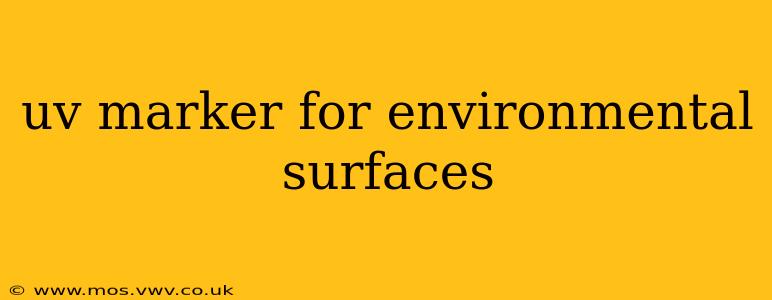UV markers, also known as ultraviolet markers or blacklight markers, are special pens that contain inks only visible under ultraviolet (UV) light. Their unique property makes them incredibly useful for a wide variety of applications, especially in environmental monitoring and security. This comprehensive guide explores the diverse uses of UV markers for environmental surfaces, addressing common questions and providing insightful information.
What are UV Markers Used For on Environmental Surfaces?
UV markers find extensive use in environmental settings due to their ability to leave a virtually invisible mark, ideal for tracking and monitoring various aspects of the environment. Their applications range from marking wildlife for research to identifying contaminated areas for cleanup. Specific applications include:
- Wildlife Tracking and Research: Researchers use UV markers to mark animals for observation without disturbing their natural behavior. The markings are easily detectable under UV light, allowing scientists to track movement patterns, social interactions, and other vital data.
- Environmental Monitoring: UV markers are employed to mark specific areas of interest within an ecosystem, such as contaminated soil or water bodies. This allows researchers to easily locate and monitor these areas over time.
- Crime Scene Investigation: Though not strictly environmental, UV markers can be used in crime scenes located outdoors. They aid in marking evidence and tracking the movements of suspects or victims.
- Security and Anti-Counterfeiting: UV ink is used to mark valuable assets or documents to deter theft and counterfeiting. This is relevant in environmental contexts where expensive equipment or research materials are involved.
- Plant Studies: Researchers may use UV markers to track plant growth, mark specific plant specimens, or identify areas for treatment or experimentation.
What Types of UV Markers are Best for Environmental Surfaces?
The best type of UV marker for environmental applications depends on the specific surface and intended use. Factors to consider include:
- Surface Material: Porosity and texture influence ink absorption and visibility. Markers designed for porous surfaces (like wood or paper) will differ from those intended for non-porous surfaces (like glass or metal).
- UV Light Source: The intensity and wavelength of the UV light used to detect the markings will affect the marker's visibility. Ensure the marker is compatible with the light source you'll be using.
- Persistence: The duration the markings remain visible under UV light is crucial. Some inks fade quicker than others, so choosing a long-lasting marker is important for long-term monitoring.
- Environmental Conditions: Consider the effects of weather, sunlight, and other environmental factors on the marker's visibility and longevity.
Are UV Markers Harmful to the Environment?
The environmental impact of UV markers depends largely on the ink composition. Reputable manufacturers typically use inks with minimal environmental impact, but it's always best to choose markers specifically designed for environmentally sensitive applications. Look for markers labeled as non-toxic or biodegradable where possible. Always follow the manufacturer's instructions for proper use and disposal.
How Long Do UV Markers Last on Environmental Surfaces?
The longevity of UV markers on environmental surfaces varies widely depending on the surface type, environmental conditions, and the specific marker used. Some markings might last for several weeks or months, while others might fade much more quickly. Factors like direct sunlight, rain, and humidity significantly impact the persistence of the markings.
What is the Best Way to Remove UV Markers from Environmental Surfaces?
Removal methods depend on the specific surface and the ink used. For some surfaces, simple cleaning with water or a mild detergent might suffice. Others may require more specialized cleaning agents. Always test any cleaning solution on a small, inconspicuous area first to avoid damaging the surface. For sensitive ecosystems, it's best to choose markers with inks that fade naturally over time.
Conclusion
UV markers offer a valuable tool for environmental research, monitoring, and security. Their ability to provide discrete and traceable markings opens up a wealth of opportunities for scientists, researchers, and conservationists. By carefully selecting the appropriate marker for the specific application and understanding its limitations, you can effectively utilize UV markers to improve our understanding and protection of the environment. Remember to always prioritize environmental safety and responsible usage.
